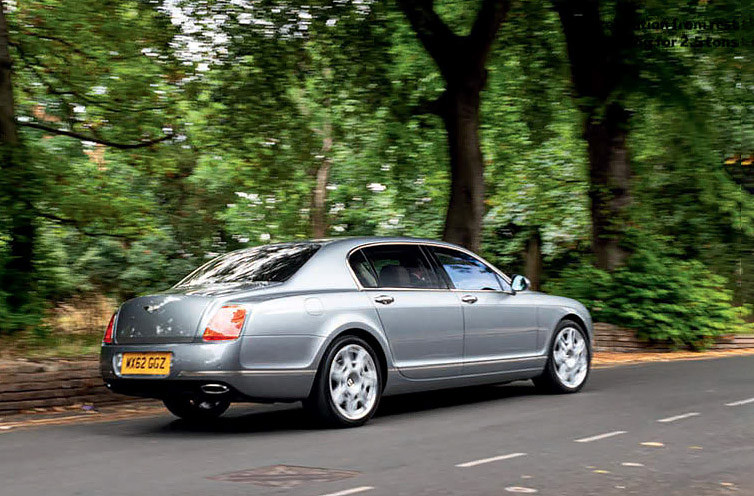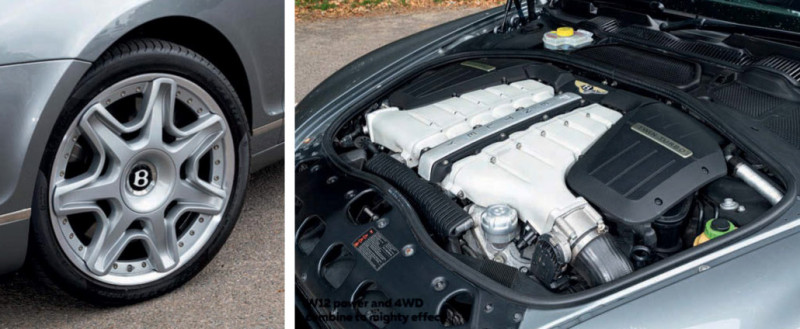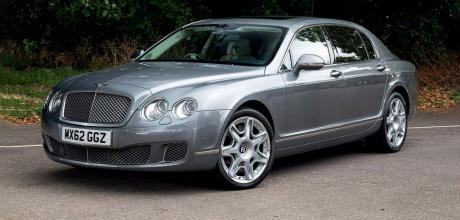2012 Bentley Flying Spur
The idea of a sports limousine seems like an oxymoron, but a few minutes with a Bentley Flying Spur like this 2012 example shows that Bentley achieved something we’d once have thought impossible.
WORDS: NIGEL BOOTHMAN
PHOTOGRAPHY: GREG EVANS
BENTLEY FLYING SPUR GT POWER, LIMO LEGROOM: BEST OF BOTH WORLDS?
A road test of the fastest four-door around

The concept of a fast, powerful limousine capable of whisking its occupants across continents at high speed is nothing new. Indeed, Bentley themselves were doing just that almost 100 years ago with the 6½-litre and then the 8-litre model, as discussed on page 26 of this issue. But going quickly in a straight line is not difficult; you just pile on the power and hang the expense. Getting a car with limousine-esque accommodation to behave like a sports car, or at least like a wieldy grand tourer, just wasn’t on the cards until quite recently.

‘You can generate considerable g-forces, both through braking and rocket-ship acceleration but also laterally, thanks to those huge rubber paws and their endless grip and traction.’
Mercedes-Benz got close with successive S-class models, but it took AMG or Brabus to make them stop, steer and go really well. Ditto BMW’s 7-series and the rare Alpina versions. Maserati’s more recent Quattroportes, the QP V and QP VI are wonderful to drive fast thanks to the Ferrari V8 and the lively chassis, but the rear seat accommodation is no different to most mid-sized saloons, albeit in nice soft Italian hide. Perhaps the recent Jaguar XJ got closest in long wheelbase ‘L’ form, with toys galore and legroom aplenty for lucky passengers, though you’d need to choose the five-litre V8 version to compete. So how did Bentley, freshly reorganised in Volkswagen’s ownership, come up with something as impressive as the Flying Spur?

By starting with a fantastic two-door GT car. The Continental GT and GTC with their 4WD system and W12 engines reset what could be expected from a grand tourer in terms of effortlessly potent performance, practicality and comfort. The two cars – GT and Flying Spur – were developed side by side, though the GT was first to market by two years. The Continental Flying Spur, to give it its full name, was actually the more aerodynamic of the two and weighed only 100kg more than the GT – and 10kg less than the GTC. Perhaps it’s no surprise that the Flying Spur was indeed the fastest four-seater production car in the world when it was launched in 2005, touching 195mph.
SPEED – THWARTED
It seems unlikely we’ll reach 195mph in West London this afternoon. We nose the car out of Hanwells’ showroom and into the city traffic, seeking a quiet spot for a few photos and some more open stretches to give the Bentley free reign. It seems to have a more subdued profile than either the GT / GTC model or the contemporary Rolls- Royce Phantom VII, which is so tall and imposing where this Bentley is low and sleek. You seem to sit a good deal lower than in an Arnage, which overlapped with this model by four years, and anyone choosing between them when new would soon notice the differences.
Here we have sculpted, firm, sports- GT seats rather than armchairs, and a dash that curves around the driver like the cockpit of a fast jet. Controls are tipped with knurled stainless steel and there is a pair of gearshift paddles above the column stalks. Despite being the Arnage’s stablemate, it’s a different bloodline and different generation.
The ride over potholed city streets is impressive for a car with huge alloy wheels, low profile tyres and relatively short suspension travel. But we’re firmly in compromise territory, where the demands of body control and neat handling placed upon a two-and-a- half ton car mean that this is not quite a magic carpet. Nonetheless, the air springs and adaptive electronic dampers do an amazing job in their attempt to cope with all conditions. This is a Mulliner version, with diamond stitching galore and comical touches like drilled pedals…a nod to the motorsport practice of drilling everything for lightness, but unlikely to make a measurable difference in this car. It has a cocooned feel, rather than a cosseting one; there is just enough headroom but no more. The car’s waistline feels high, which offers an agreeably protected sensation to occupants.
Time to pull over and explore the space for those who are not at the helm. The difference between this and the room available in the back of the Continental GT is staggering. It would have been easy for Bentley’s stylist Dirk van Braeckel to concentrate on sporting proportions and leave us with a snug, close-coupled saloon, but he and Bentley’s product planners took the opposite route. They created very nearly as much legroom in the Flying Spur as you would find in the LWB version of previous Arnages and SZ-generation cars. It’s more than just the luxury of space, too – rear seat occupants get their own overhead console for the control of various lighting options, their own bank of climate control knobs in the rear of the centre console and their own electrically sliding, tilting and memory-setting seats. Privacy glass completes a thoroughly appealing environment for any long road journey.
THE LURE OF THE FAST LANE
We’re anxious to discover what this car can do on the open road. Will it shrink around us like the best fullsized powerhouses, or lurch and wallow where the GT remains poised? When the photographer has finished his work, his camera bag, tripod and light-stands look lost in the Spur’s generous boot. Time to climb aboard and explore the rev range. There is still a key to insert; more a nod to traditionalism than a necessity.
Press the button labelled START and there’s a distant explosion you feel through the soles of your feet, as though you’re somewhere near a quarry and they’ve started blasting. That’s the W12 coming to life, rather more quietly than in the sportier variants of the GT, where the sound is allowed to add to the drama. Somehow, this six-litre engine with a peak output of 552bhp is barely detectable in the first third or even half of the rev counter, so the feeling is not unlike that of an EV: instant response, linear acceleration, near silence. Until you stick it into S for Sport, use the paddles and hang on to each gear. It is blisteringly quick. Here is where the experience becomes almost indistinguishable from the Continental GT: the steering has enough feel and accuracy to hit every corner’s apex but the four-wheel drive system never shows a hint of losing grip. Understeer, because you went in too fast? Not really – just keep your foot down and the front wheels pull you round. Oversteer, because you booted it too roughly on the way out? No, that would be rather undignified. It just squats down slightly and fires you into the horizon, bellowing like an angry god.
Anyone who’s driven an Arnage, particularly a later more powerful one such as an Arnage R or T will be familiar with that relentless charging acceleration that doesn’t seem to take account of the speed you’re already doing. For instance, 40mph to 70mph is accomplished in a way that suggests it wouldn’t take much longer to romp from 120mph to 150mph. Not that we can discover this in south east England, of course. Does it need to be this fast? Of course not. But it’s great fun, and it has only one downside.
This an effect of the car’s ability to entertain you on fast, twisty roads. You can generate considerable g-forces, both through braking and rocket-ship acceleration but also laterally, thanks to those huge rubber paws and their seemingly endless grip. Forget you’re in a passenger liner and you’ll soon hear squeals of rage from the back seat as you smear your guests against the side windows like spilt coffee. It’s hardly a serious whinge, though. This car is too versatile to complain about for long. It can tick the box for a silent city limousine, for solo entertainment on an A-road blast and for a family holiday in the South of France – 26mpg or even more on the motorway is perfectly possible and the boot, as we’ve discovered, will swallow all your kit.
It's with some regret, then, that we hand it back to Stephen Brown, proprietor of Hanwells. He usually has several such cars in stock (and this one sold before we went to press) ranging from the low £20,000s for the 2005 and 2006 cars with higher mileage to as much as £80,000 for a lovely second-gen example from 2013 onwards. A new Flying Spur now tops £170,000, so a pampered pre-owned example with a full book of stamps is outrageously good value after depreciation like that. Bentley took so many orders for the Flying Spur in the year after it was launched that Crewe couldn’t keep up with demand, and 1350 had to be built in Germany instead. Go and try one – you’ll soon understand why.
Thanks to: Hanwells of London, hanwells.net or call 0208 567 9729
TECHNICAL DATA 2012 Bentley Flying Spur
- LENGTH: 5290mm
- WIDTH: 1976mm
- WEIGHT: 2485kg
- ENGINE: W12 turbo
- MAX POWER: 552bhp @ 6100rpm
- MAX TORQUE: 479lb ft @ 1600rpm
- TRANSMISSION: 8-speed automatic ZF8HP
- 0-60MPH: 5.0s
- TOP SPEED: 195mph
- ECONOMY: 11/17/26mpg, urban/combined/m-way
- COST NEW: from £115,350 (2005)
- PRICE NOW *2023-2024: c. £38,000 (for a 2012 car)
Cornering poise is impressive for a car of this length and mass Now...can I afford one?
Legroom aplenty and reclining seats Narrow opening but a very deep space within Driver's environment is sporting and soothing Rear compartment controls in equal measure.
Acceleration from rest is startling for 2.5 tons. Long rear door hints at room within W12 power and 4WD combine to mighty effect.


